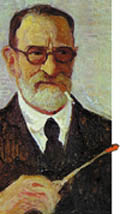
His father, Juan Figari de Lazaro, was emigrating from Santa Margherita Ligure, Italy to Buenos Aires, Argentina when his ship sank, and swimming he reached the shores of Montevideo, where he settled. Pedro Figari was born in Montevideo, Uruguay in 1861, and spent much of his childhood on a farm in what is now downtown Tres Cruces, facing a port of Montevideo Bay. In this semi-rural neighborhood, a young Figari gets in touch with aspects of society that would eventually become the subjects he developed in his painting. He had always painted as an amateur, but in 1921 he sent a number of his paintings to Buenos Aires for an exhibition. Although the exhibition was not a commercial success (only one painting had sold), he was warmly greeted by the cultural community, so he decided to move to Buenos Aires to pursue his career as a painter. In 1925 he sent another lot to Paris, and this time sells about half his paintings. He then moved to Paris, where he continued painting until 1933. He decided to sail back to Montevideo, where he arrived in 1934. Pedro Figari died in Montevideo in 1938.
* by Fernando Saavedra Figari, written for Pedro Figari Exhibition, Montevideo, Oct-Nov 1998
It is estimated that during almost 15 years of his life, he had created over 4,000 paintings. A great portion of his work focuses on the Afro-Uruguayan community, and the memories of his youth. His memories of Candombe.
I have always lived on the margins of written poetry, like the most mystical of the uncouth, and I feel human: I laugh, cry, suffer, moved, I tremble and am utterly startled, and submit mad like a lover to my dreams. As I approach the end, without knowing why, suddenly I feel the irresistable desire to display my dreams, believing them to be good, and if they hold some human essence they are good, and I hope they live, they are my guide.
* written by Pedro Figari, Paris 1927, in the preface "El Arquitecto". Figari speaks of his human conditions. Excerpt from the book 'Figari', 1984, by Samuel Oliver from the collection "Artistas de Americas".










As candombe continues to breathe life on the streets of Montevideo, it also continues to be a source of inspiration to generations of painters.
Gallery #2 Fernando Gomez Germano
Gallery #3 Daniel Pontet
Gallery #4 Homer "Perucho" Diano
Gallery #5 Chichito Cabral
Gallery #6 Ruben Galloza
Gallery #7 Victor Ocampo Vilaza
Gallery #8 Silvia Segundo
